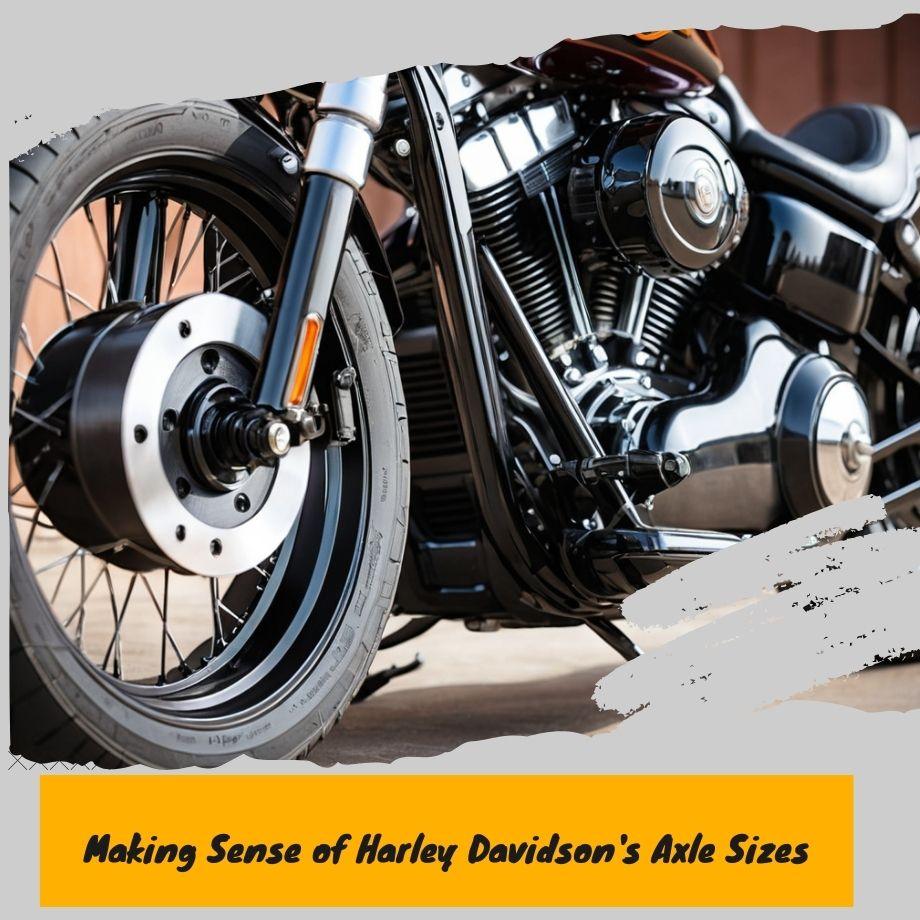The Complete Harley Davidson Axle Size Guide

Understanding Harley-Davidson Axle Sizes
As a Harley enthusiast, understanding the axle sizes used on your motorcycle is crucial for ensuring proper fitment, performance, and safety. Axles are the central shafts that allow the wheels to rotate, and their size plays a vital role in determining the overall stability, handling, and load-bearing capacity of your bike.
Harley-Davidson has a rich history of producing iconic motorcycles, each with its own unique axle size requirements. From the classic Sportster models to the powerful touring bikes like the Road King and Electra Glide, Harley has employed a range of axle sizes to accommodate different engine displacements, wheel sizes, and riding styles.
The importance of proper axle size selection cannot be overstated. Using an incorrect axle size can lead to a multitude of issues, including premature wear, vibrations, and even catastrophic failures. Oversized axles can cause excessive stress on the wheel bearings and suspension components, while undersized axles may not provide sufficient strength and durability for the intended load.
Moreover, axle sizes are closely tied to the specific Harley-Davidson model and year, as the company has continuously refined and improved its designs over the years. This means that simply referring to a generic axle size chart may not provide the accurate information you need for your particular motorcycle.
Types of Axles Used on Harley-Davidson Motorcycles
Harley-Davidson motorcycles employ various types of axles, each designed to meet specific performance and durability requirements. The most common axle types found on Harleys are solid axles, hollow axles, and splined axles.
Solid Axles: Solid axles are one-piece, solid shafts that are typically used on older Harley models or custom builds where simplicity and strength are prioritized. These axles are robust and capable of handling high torque loads, making them suitable for heavy-duty applications. However, their weight can contribute to increased unsprung mass, affecting handling and suspension performance.
Hollow Axles: As the name suggests, hollow axles have a hollow center, reducing their overall weight compared to solid axles. This weight reduction helps improve handling and suspension performance by decreasing the unsprung mass. Hollow axles are commonly found on modern Harley-Davidson models, where weight savings and improved handling characteristics are desired.
Splined Axles: Splined axles feature a series of grooves or splines along their surface, allowing them to interface with matching splines on components like brake rotors or sprockets. This splined design enables secure and precise positioning of these components, ensuring proper alignment and preventing slippage under high torque loads. Splined axles are widely used on Harley-Davidson models for their ability to transmit power efficiently and maintain component alignment.
The construction of these axles varies based on their intended application and the specific Harley-Davidson model. Solid and hollow axles are typically made from high-strength steel alloys, while splined axles may incorporate additional heat treatment or surface hardening processes to enhance their durability and wear resistance.
Harley-Davidson Axle Size Chart
One of the most critical components of a Harley-Davidson motorcycle is the axle, which plays a crucial role in the overall performance, handling, and safety of the bike. Knowing the correct axle size for your specific Harley model and year is essential for ensuring proper fit, functionality, and compatibility with other components. In this section, we'll provide a comprehensive chart listing the axle sizes for various Harley-Davidson models and years, along with explanations for any variations or exceptions.
Harley Davidson axle size chart
| Model | Year Range | Front Axle Size | Rear Axle Size | Notes |
|---|---|---|---|---|
| Sportster | 1957-2003 | 3/4 inch | 1 inch | - |
| Sportster | 2004-Present | 25 mm | 25 mm | Metric sizes introduced |
| Dyna | 1991-2017 | 1 inch | 1 inch | - |
| Softail | 1984-Present | 1 inch | 1 inch | - |
| Touring | 1980-Present | 1 inch | 1 inch | - |
| V-Rod | 2002-2017 | 25 mm | 25 mm | Metric sizes used |
Please note that this chart provides general guidelines, and there may be variations or exceptions depending on specific model configurations, custom builds, or modifications. Additionally, some older Harley-Davidson models may have different axle sizes, so it's always recommended to consult your owner's manual or a professional mechanic for accurate information specific to your motorcycle.
It's also important to note that axle sizes can vary between the front and rear axles on some models, as indicated in the chart. Front axles are typically smaller in diameter than rear axles to accommodate the steering mechanism and front suspension components.
When replacing or upgrading axles, it's crucial to ensure compatibility with the wheel hubs, bearings, and other components to maintain proper fitment and prevent potential safety issues or damage to the motorcycle.
Importance of Proper Axle Size Selection
Selecting the correct axle size for your Harley-Davidson motorcycle is crucial for ensuring safe and optimal performance. Using an axle that is too small or too large can have severe consequences and compromise the overall riding experience.
If an axle is undersized, it may not be able to withstand the stress and loads placed upon it during operation. This can lead to axle failure, which could result in a catastrophic loss of control and potential accidents. Additionally, an undersized axle may cause excessive wear on other components, such as bearings and wheel hubs, leading to premature failure and increased maintenance costs.
On the other hand, using an oversized axle can also be problematic. An axle that is too large may not fit properly within the wheel hub or swing arm, causing misalignment and potential binding issues. This can lead to excessive wear, vibrations, and handling problems, making the motorcycle difficult to control and potentially dangerous to ride.
Furthermore, an improper axle size can affect the overall balance and weight distribution of the motorcycle, which can negatively impact handling characteristics, braking performance, and overall stability.
To avoid these issues, it is essential to consult the Harley-Davidson axle size chart and follow the manufacturer's recommendations for your specific motorcycle model and year. This ensures that the correct axle size is used, providing a safe and enjoyable riding experience while minimizing the risk of component failure or handling problems.
Axle Size Considerations for Custom Builds and Modifications
When it comes to custom Harley builds or modifications, selecting the right axle size is crucial for ensuring proper performance, safety, and longevity. Deviating from the manufacturer's recommended axle sizes can have significant consequences, so it's essential to approach this aspect with caution and careful consideration.
One of the primary factors to consider is the intended use of the motorcycle. If you're building a high-performance machine or planning to add significant weight through modifications, you may need to opt for a larger axle size to handle the increased stress and loads. Conversely, if you're aiming for a lighter, more agile build, a smaller axle size might be more suitable.
Another important consideration is the type of wheels and tires you plan to use. Larger wheels and wider tires generally require a larger axle size to provide adequate support and prevent premature wear or failure. It's essential to ensure compatibility between the axle size, wheel size, and tire dimensions to maintain proper alignment and prevent rubbing or clearance issues.
If you're planning to modify the suspension or change the rake and trail geometry of your Harley, this can also impact the axle size requirements. Alterations to the bike's geometry can affect the load distribution and stress on the axles, necessitating adjustments to ensure optimal performance and safety.
Additionally, it's crucial to consider the braking system when selecting an axle size. Larger axles can accommodate larger brake rotors and calipers, which can improve braking performance and heat dissipation. However, it's essential to ensure that the axle size is compatible with the intended brake components to prevent clearance issues or excessive stress on the axle.
When building a custom Harley or making modifications, it's highly recommended to consult with experienced builders, mechanics, or engineers who can provide guidance based on your specific plans and requirements. They can help you navigate the complexities of axle size selection, ensuring that your custom build or modification is not only visually stunning but also safe and reliable on the road.
Measuring Axle Size on Your Harley
Accurately measuring the axle size on your Harley-Davidson motorcycle is crucial for ensuring proper fitment when replacing or upgrading components. Here's a step-by-step guide to help you determine the axle size on your bike, along with the necessary tools and tips for precise measurement.
Tools Needed:
- Caliper or micrometer
- Clean rag or cloth
- Penetrating oil (optional)
Step 1: Locate the Axle
The axle is the shaft that runs through the center of the wheel hub, allowing the wheel to rotate freely. On a Harley-Davidson, the axle is typically located at the rear wheel for the drive axle and at the front wheel for the steering axle.
Step 2: Clean the Axle
Before taking any measurements, it's essential to clean the axle thoroughly. Use a clean rag or cloth to wipe away any dirt, grease, or debris that may interfere with accurate measurement.
Step 3: Apply Penetrating Oil (Optional)
If the axle appears corroded or stuck, you can apply a small amount of penetrating oil to help loosen it up. This step is optional but can make it easier to take precise measurements.
Step 4: Measure the Axle Diameter
Using a caliper or micrometer, carefully measure the diameter of the axle at several points along its length. Take multiple measurements to ensure accuracy, as axle diameters can vary slightly due to manufacturing tolerances or wear.
Step 5: Record the Measurements
Note down the axle diameter measurements you've taken, rounding them to the nearest hundredth of an inch or millimeter, depending on the unit of measurement you're using.
Tips for Accurate Measurement:
- Ensure the caliper or micrometer is properly calibrated and in good working condition.
- Take measurements at different points along the axle to account for any variations in diameter.
- Clean the axle thoroughly to remove any debris that could interfere with accurate measurement.
- If the axle is difficult to access or measure, consider consulting a professional mechanic or referring to your Harley-Davidson service manual for guidance.
By following these steps and tips, you can accurately determine the axle size on your Harley-Davidson motorcycle, ensuring proper fitment and compatibility when replacing or upgrading components.
Axle Size and Wheel Compatibility
When it comes to wheel compatibility on your Harley-Davidson motorcycle, the axle size plays a crucial role. The axle size must match the wheel hub dimensions to ensure a proper fit and safe installation. Mismatched axle and wheel sizes can lead to potential safety hazards and damage to your bike.
The axle size determines the inner diameter of the wheel hub, and it's essential to match this dimension with the corresponding wheel size. Harley-Davidson offers a wide range of wheel sizes, and each size has a specific axle size requirement. For instance, a larger wheel diameter typically requires a larger axle size to accommodate the increased weight and stress.
Before installing new wheels on your Harley, it's crucial to consult the manufacturer's specifications or refer to the axle size chart to ensure compatibility. Attempting to fit a wheel with an incompatible axle size can result in a loose or improper fit, potentially causing the wheel to wobble or even detach while riding, leading to dangerous situations.
In addition to the axle size, it's essential to consider other factors that affect wheel compatibility, such as the wheel width, offset, and brake caliper clearance. Wider wheels may require spacers or different brake calipers to accommodate the increased width, while offset changes can affect the handling and suspension geometry.
Proper wheel installation is also critical for safety. Ensure that the wheel is securely mounted on the axle, and all fasteners are tightened to the recommended torque specifications. Regularly inspect the wheels and axles for any signs of wear, damage, or looseness, and address any issues promptly to maintain the safety and performance of your Harley-Davidson motorcycle.
Axle Size and Braking Performance
Proper axle size selection is crucial for ensuring optimal braking performance on your Harley-Davidson motorcycle. The axle plays a vital role in transferring braking forces from the wheel to the frame, and an incorrectly sized axle can compromise your bike's stopping power and overall safety.
When it comes to braking, a larger axle diameter is generally preferred. Thicker axles are stronger and more resistant to bending or flexing under the immense forces generated during hard braking. This rigidity allows for more efficient transfer of braking forces, resulting in improved braking responsiveness and shorter stopping distances.
However, it's important to strike a balance between axle size and weight. While larger axles offer better braking performance, they also add more unsprung mass to the wheel assembly, which can negatively impact handling and suspension performance. Manufacturers like Harley-Davidson carefully consider this trade-off when designing their motorcycles.
Another factor to consider is the axle material. High-strength alloys, such as chromoly steel, are often used in axle construction for their superior strength-to-weight ratio and resistance to fatigue and deformation under extreme loads. These materials can allow for smaller axle diameters while still providing the necessary strength and rigidity for effective braking.
If you're planning any modifications or upgrades to your Harley's braking system, such as installing larger brake rotors or more powerful calipers, it's essential to ensure that your axle is up to the task. Increased braking forces can potentially overload an undersized axle, leading to premature wear, flexing, or even failure.
In summary, selecting the appropriate axle size is crucial for maximizing braking performance and safety on your Harley-Davidson motorcycle. Larger axle diameters and high-strength materials can provide the necessary rigidity and strength to withstand the immense forces generated during braking, while maintaining an optimal balance with weight and handling considerations.
Maintenance and Inspection of Harley-Davidson Axles
Proper maintenance and inspection of your Harley-Davidson's axles are crucial for ensuring safe and reliable performance. Regular checks can help you identify potential issues before they escalate and prevent costly repairs or breakdowns on the road.
Recommended Maintenance Practices:
- Inspect axles during routine maintenance intervals or before embarking on long rides.
- Check for signs of wear, such as grooves, scoring, or excessive rust.
- Ensure axle nuts or fasteners are tightened to the specified torque values.
- Lubricate axles and bearings as recommended by the manufacturer.
- Inspect axle seals for leaks or damage, as these can allow contaminants to enter the bearings.
Signs of Wear or Damage:
- Excessive play or movement in the axle, indicating worn bearings or loose fasteners.
- Unusual noises, such as grinding or clicking sounds, which can signify bearing failure or axle damage.
- Leaking lubricant from axle seals, which can lead to premature wear and contamination.
- Visible cracks, dents, or deformities in the axle, which can compromise its structural integrity.
When to Replace Axles:
- If significant wear or damage is detected during inspections.
- After a collision or impact that may have compromised the axle's integrity.
- When replacing bearings or other components that require axle removal.
- As a preventive measure after reaching the manufacturer's recommended service life.
Regular maintenance and inspection can help you identify potential issues early, ensuring your Harley-Davidson's axles remain in optimal condition for safe and enjoyable rides.
Resources for Finding Harley-Davidson Axle Sizes
When it comes to finding accurate and up-to-date information on Harley-Davidson axle sizes, it's essential to rely on reputable sources. One of the best resources is the official Harley-Davidson website and technical manuals. These provide detailed specifications and diagrams for various models, ensuring you have access to factory-recommended axle sizes.
Another valuable resource is the Harley Owners Group (H.O.G.) forums and online communities. Here, you can connect with experienced Harley enthusiasts who can share their knowledge and insights on axle sizes, compatibility, and maintenance.
Additionally, several third-party websites and publications specialize in Harley-Davidson parts and accessories. These resources often offer comprehensive axle size charts and guides, making it easier to find the right fit for your specific bike.
It's crucial to cross-reference information from multiple reliable sources to ensure accuracy and stay up-to-date with any changes or updates from Harley-Davidson. By consulting official resources, knowledgeable communities, and reputable third-party sources, you can confidently determine the correct axle size for your Harley-Davidson motorcycle.







Leave a comment